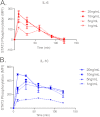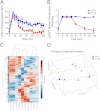Cytokine response is determined by duration of receptor and signal transducers and activators of transcription 3 (STAT3) activation
- PMID: 23166328
- PMCID: PMC3561523
- DOI: 10.1074/jbc.M112.386573
Cytokine response is determined by duration of receptor and signal transducers and activators of transcription 3 (STAT3) activation
Abstract
Paradoxically, the pro-inflammatory cytokine IL-6 and the anti-inflammatory cytokine IL-10 both activate STAT3, yet generate nearly opposing cellular responses. Here, we show that the temporal pattern of STAT3 activation codes for the specific cytokine response. A computational model of IL-6 and IL-10 signaling predicted that IL-6 stimulation results in transient activation of STAT3, with a rapid decline in phosphorylation and nuclear localization. In contrast, simulated IL-10 signaling resulted in sustained STAT3 activation. The predicted STAT3 patterns produced by each cytokine were confirmed experimentally in human dendritic cells. Time course microarray studies further showed that the dynamic genome-wide transcriptional responses were nearly identical at early time points following stimulation (when STAT3 is active in response to both IL-6 and IL-10) but divergent at later times (when STAT3 is active only in response to IL-10). Truncating STAT3 activation after IL-10 stimulation caused IL-10 to elicit an IL-6-like transcriptional and secretory response. That the duration of IL-10 receptor and STAT3 activation can direct distinct responses reveals a complex cellular information-coding mechanism that may be relevant to improving the prediction of the effects of drug candidates using this mechanism.
Figures






References
-
- Ishihara K., Hirano T. (2002) IL-6 in autoimmune disease and chronic inflammatory proliferative disease. Cytokine Growth Factor Rev. 13, 357–368 - PubMed
-
- Lio D., Licastro F., Scola L., Chiappelli M., Grimaldi L. M., Crivello A., Colonna-Romano G., Candore G., Franceschi C., Caruso C. (2003) Interleukin-10 promoter polymorphism in sporadic Alzheimer's disease. Genes Immun. 4, 234–238 - PubMed
-
- Nishimoto N., Kishimoto T. (2004) Inhibition of IL-6 for the treatment of inflammatory diseases. Curr. Opin. Pharmacol. 4, 386–391 - PubMed
-
- Tagore A., Gonsalkorale W. M., Pravica V., Hajeer A. H., McMahon R., Whorwell P. J., Sinnott P. J., Hutchinson I. V. (1999) Interleukin-10 (IL-10) genotypes in inflammatory bowel disease. Tissue Antigens 54, 386–390 - PubMed
-
- Darnell J. E. (2005) Validating Stat3 in cancer therapy. Nat. Med. 11, 595–596 - PubMed
Publication types
MeSH terms
Substances
Grants and funding
LinkOut - more resources
Full Text Sources
Other Literature Sources
Molecular Biology Databases
Miscellaneous

